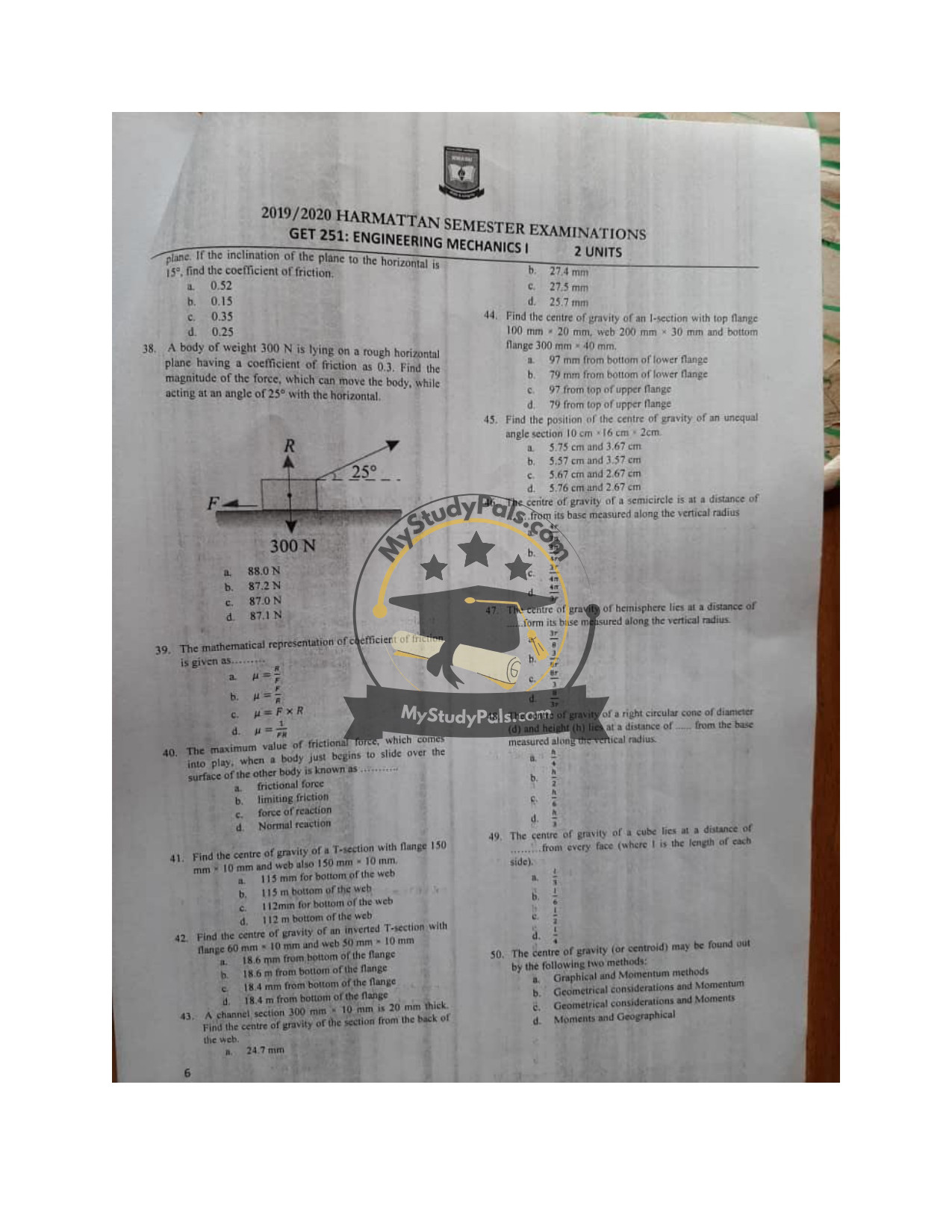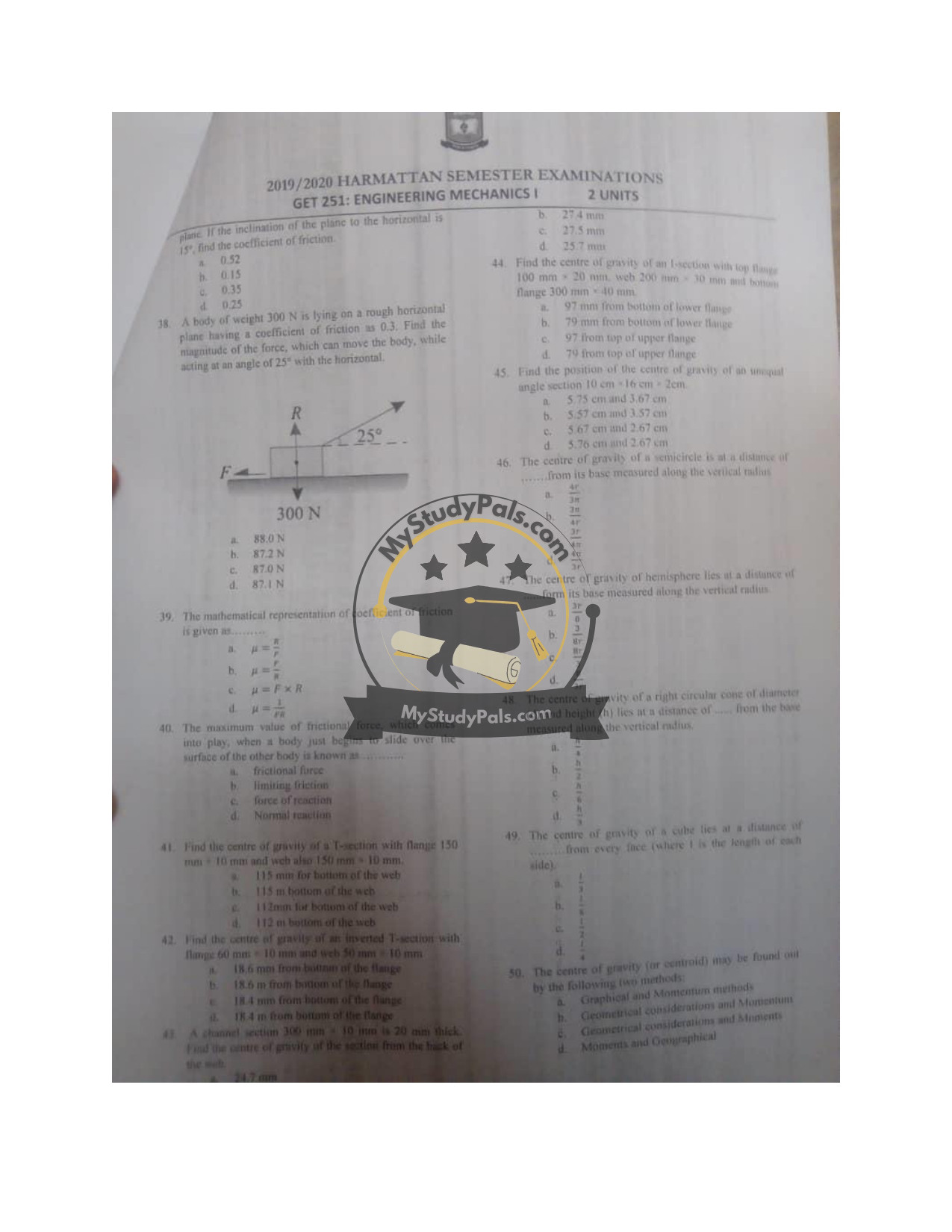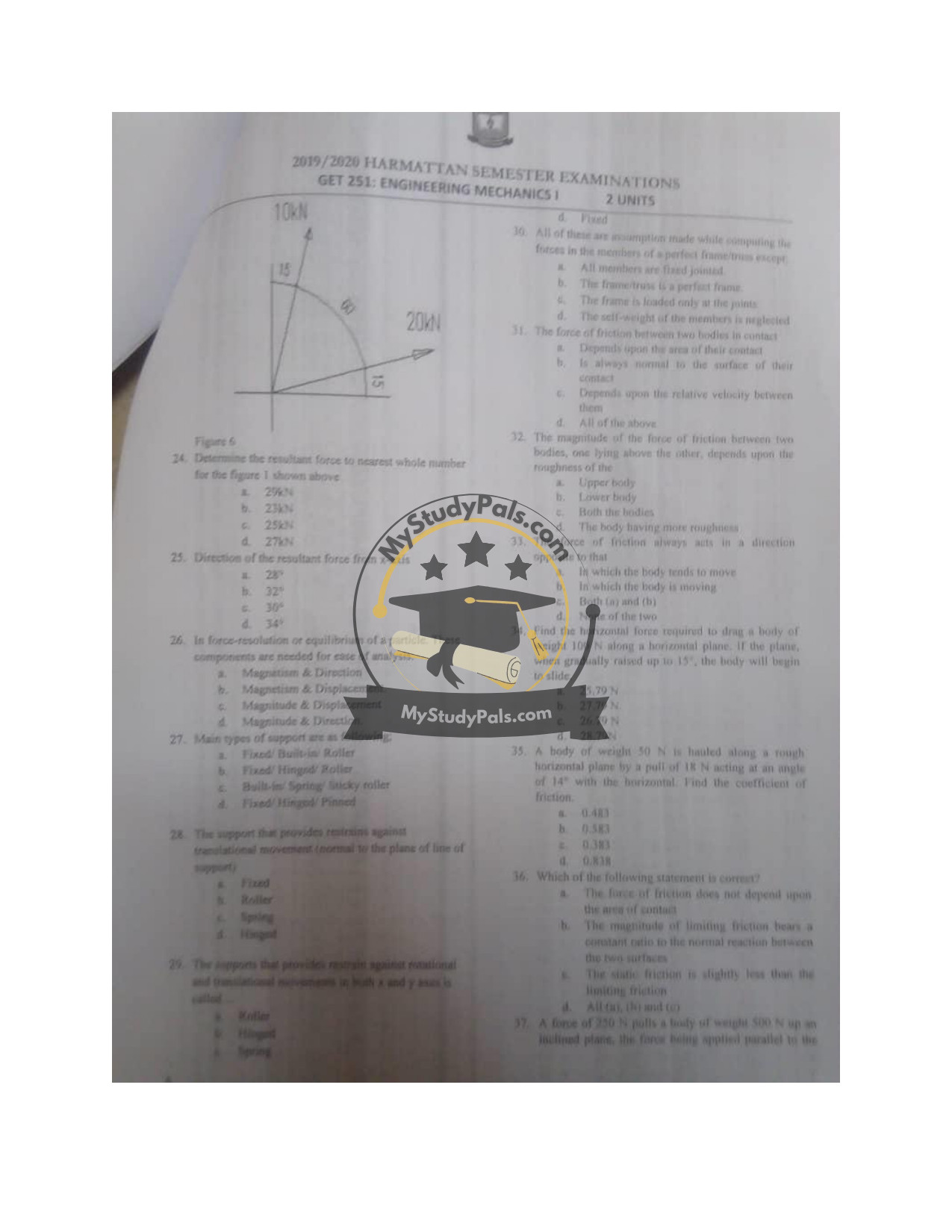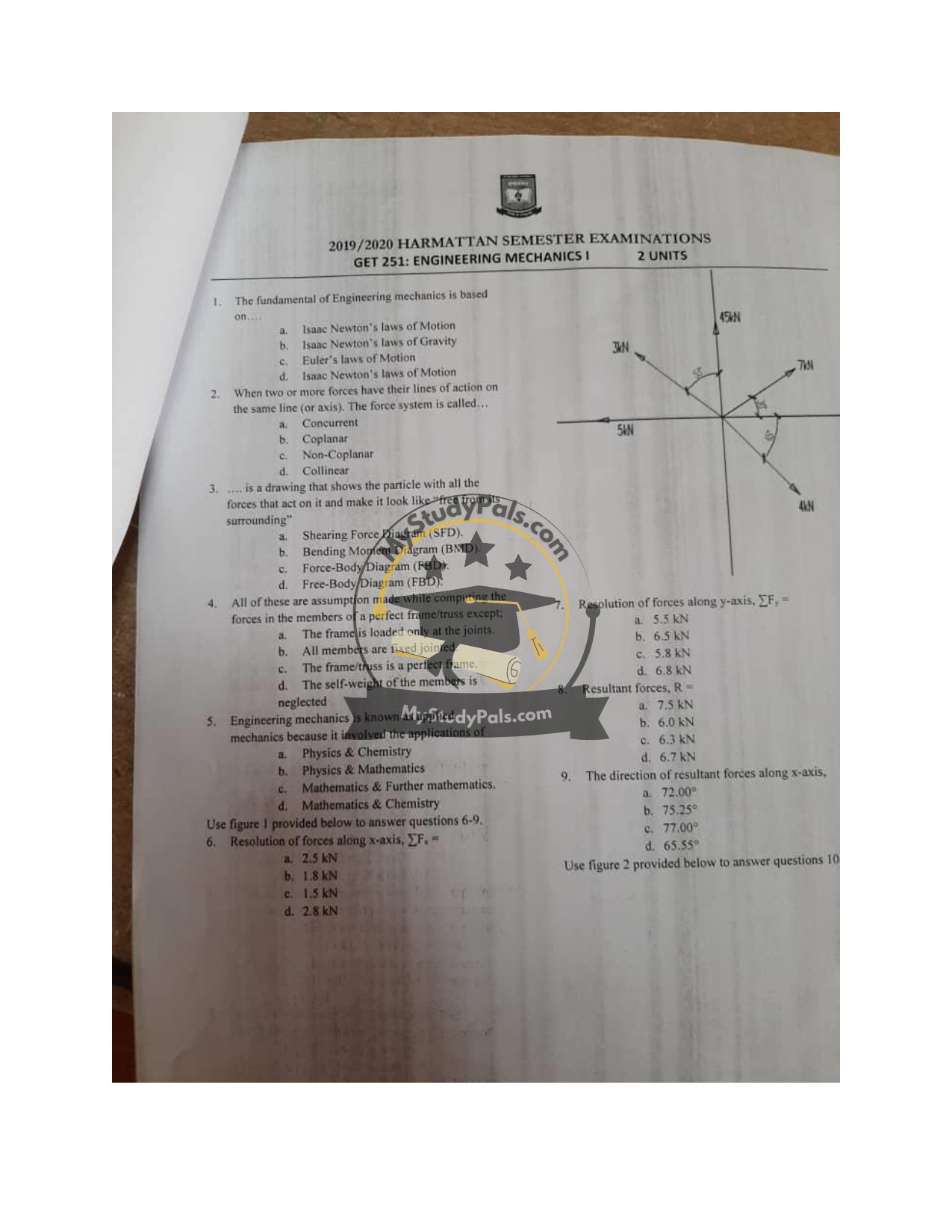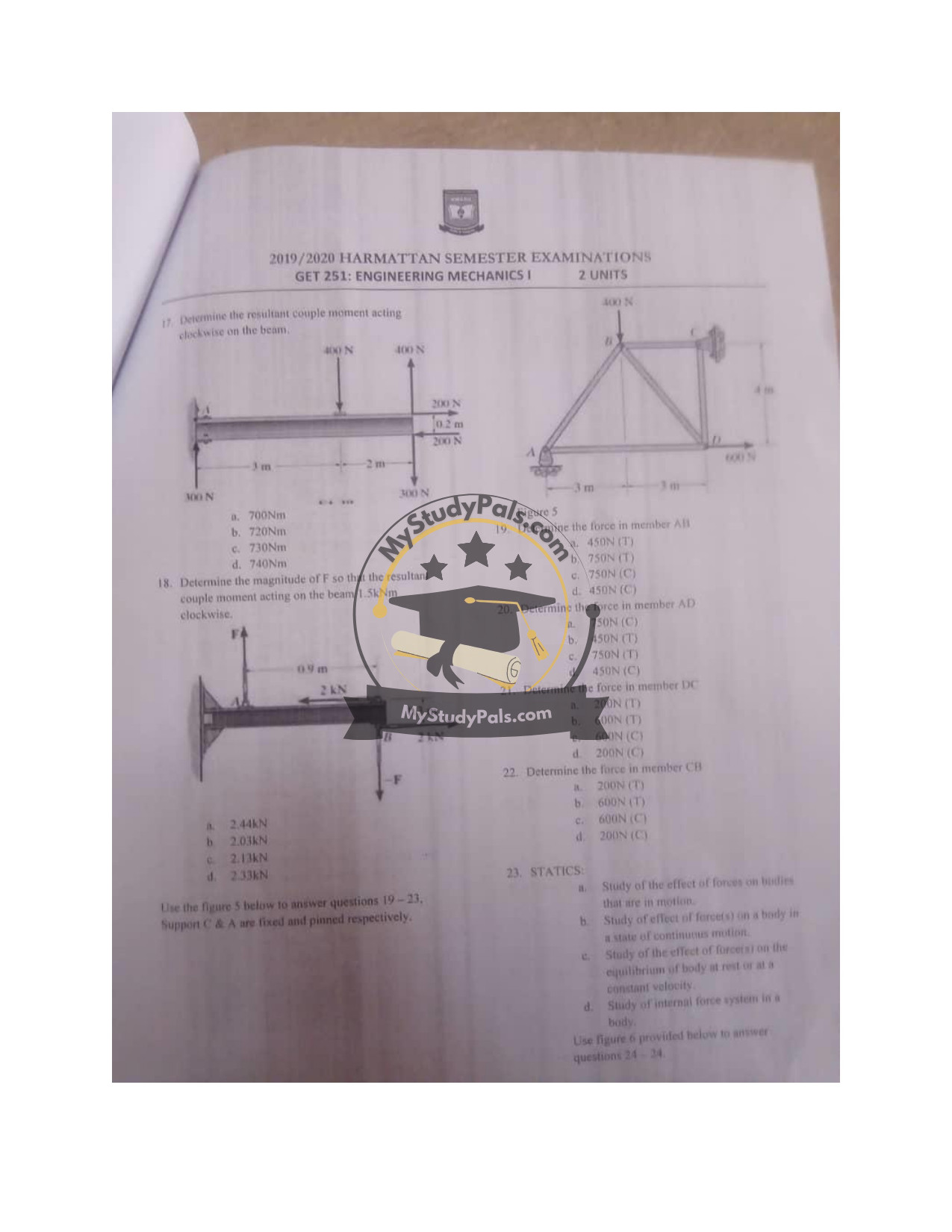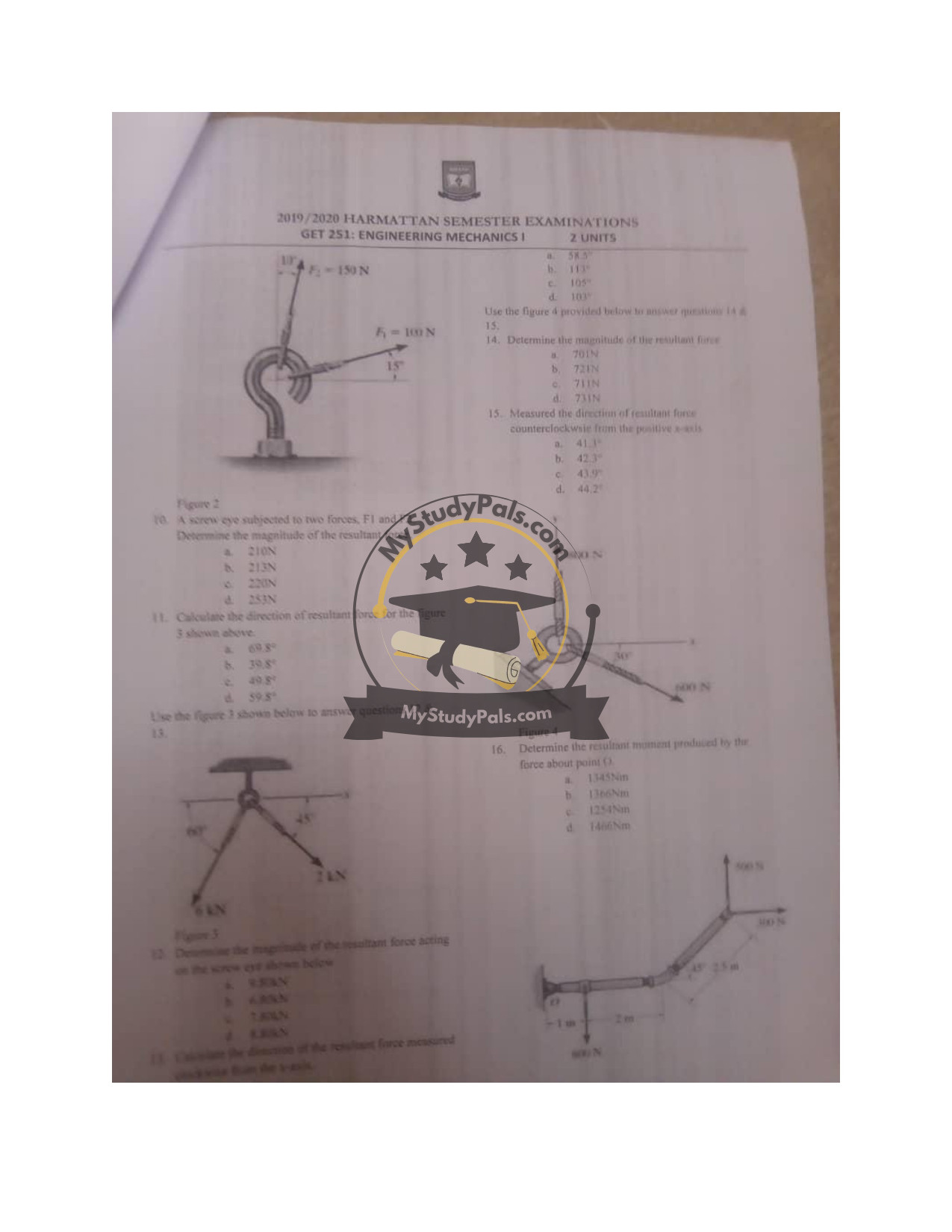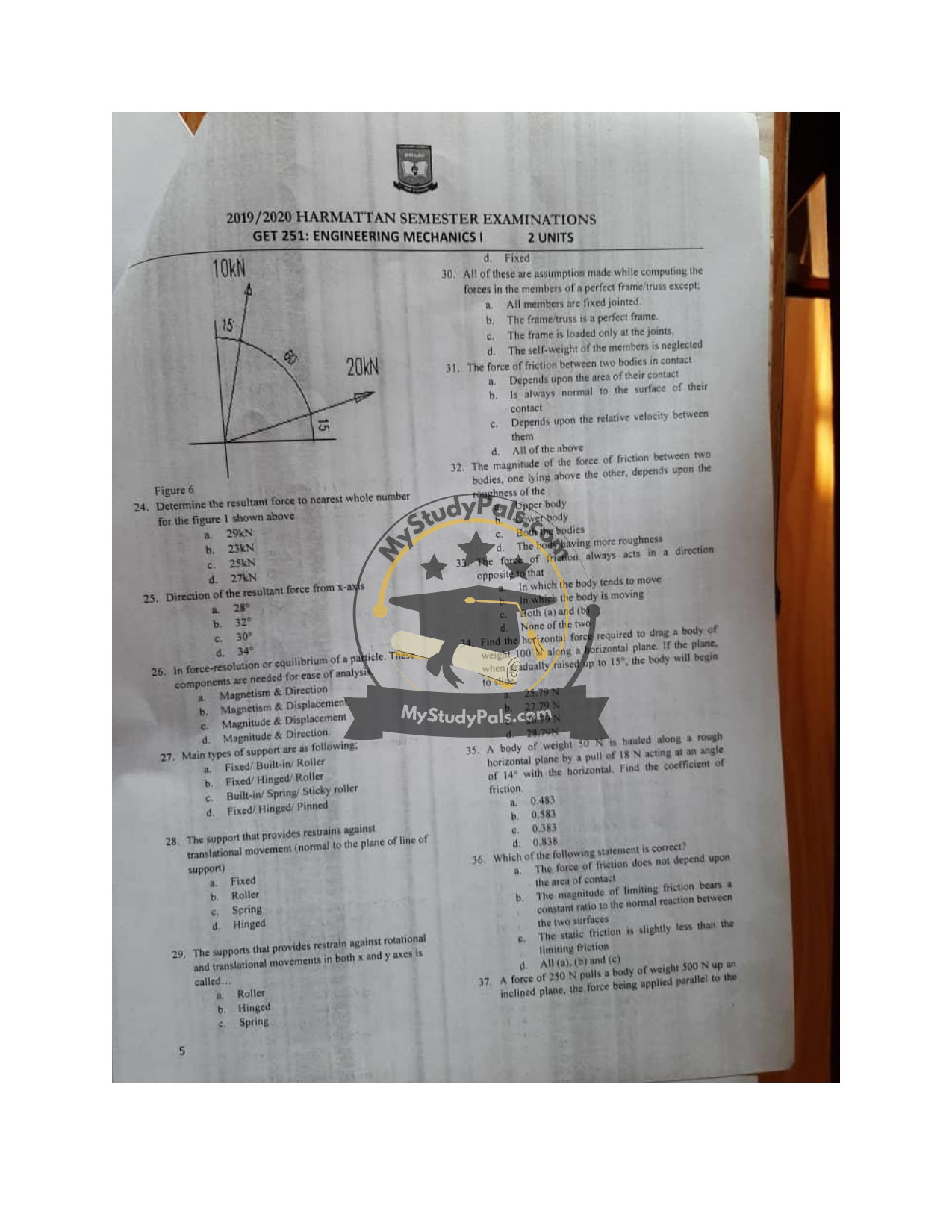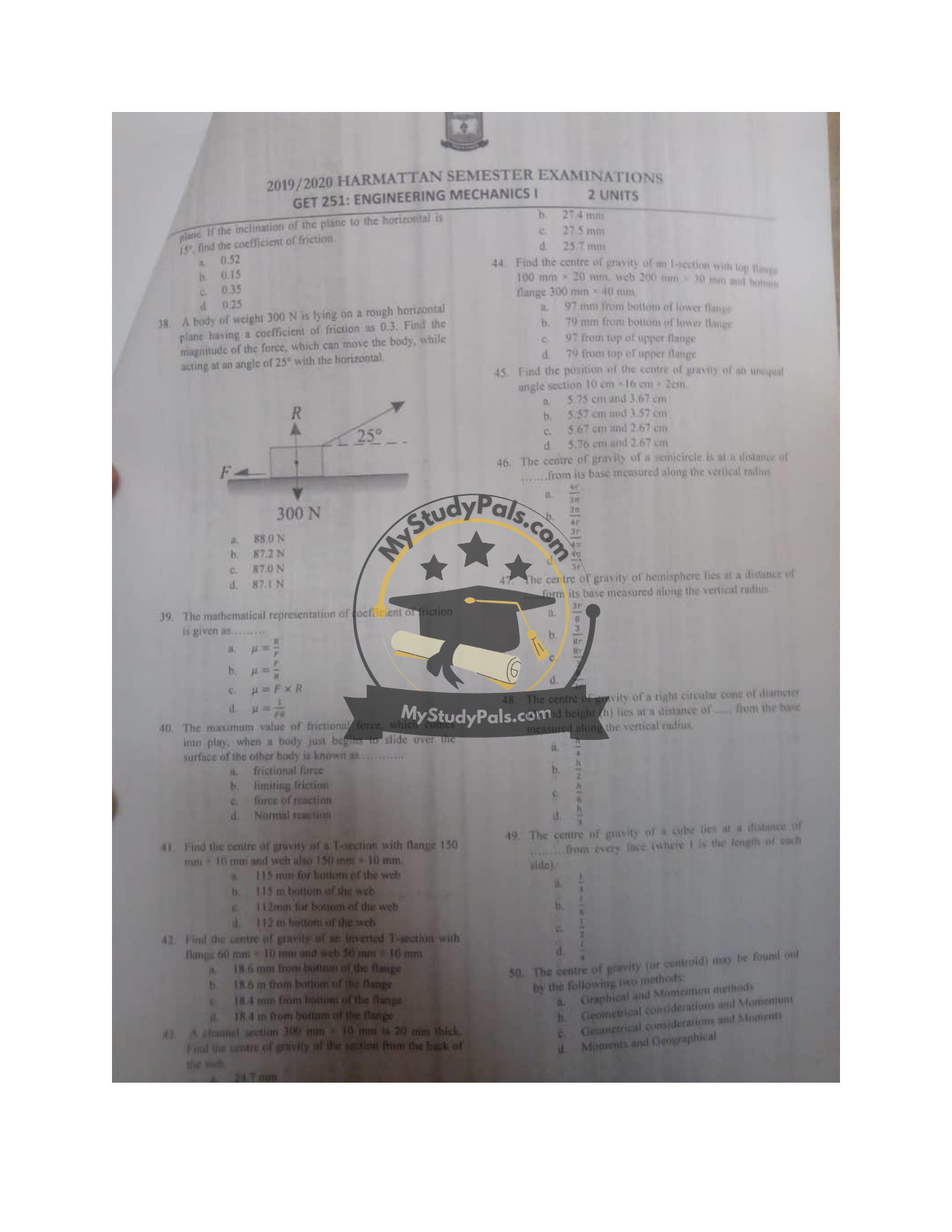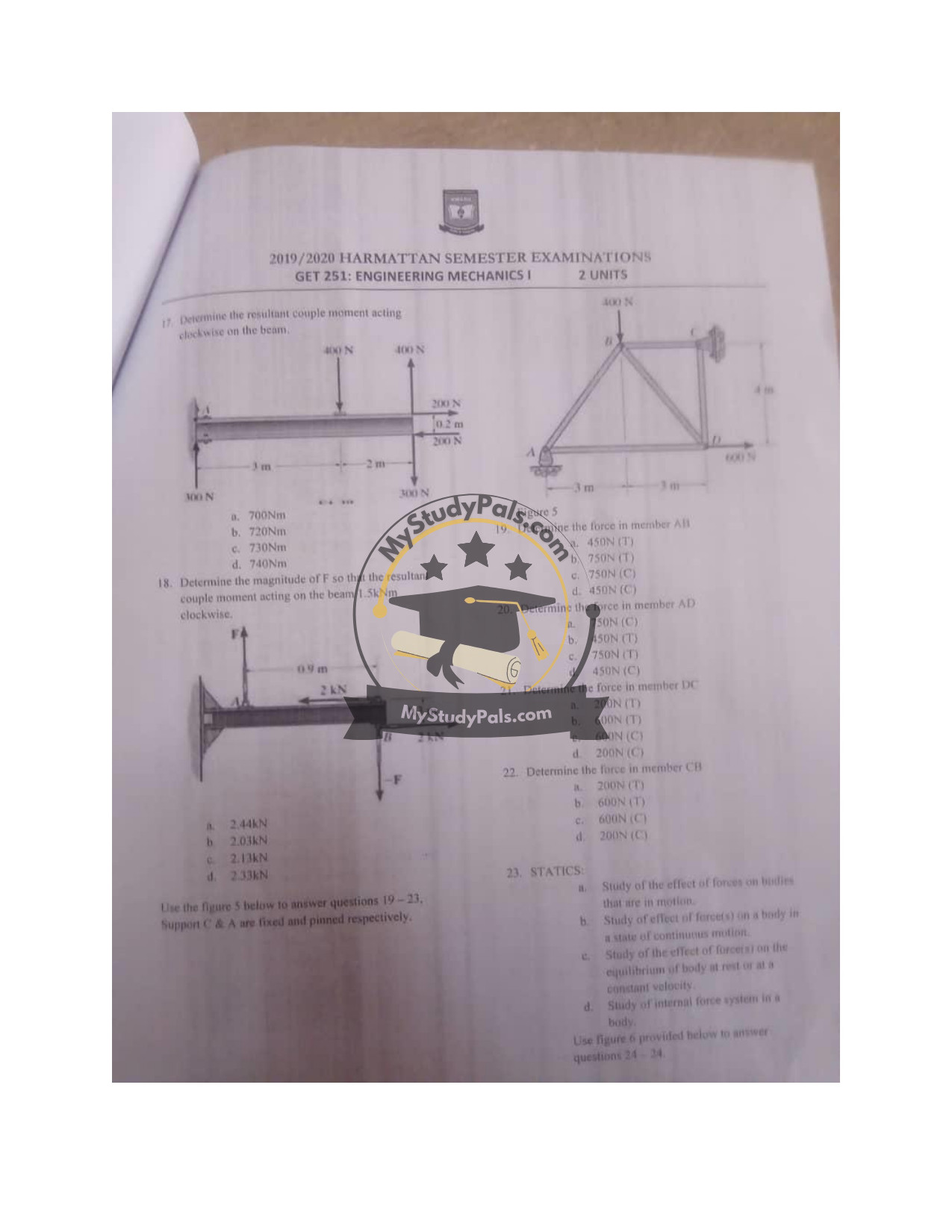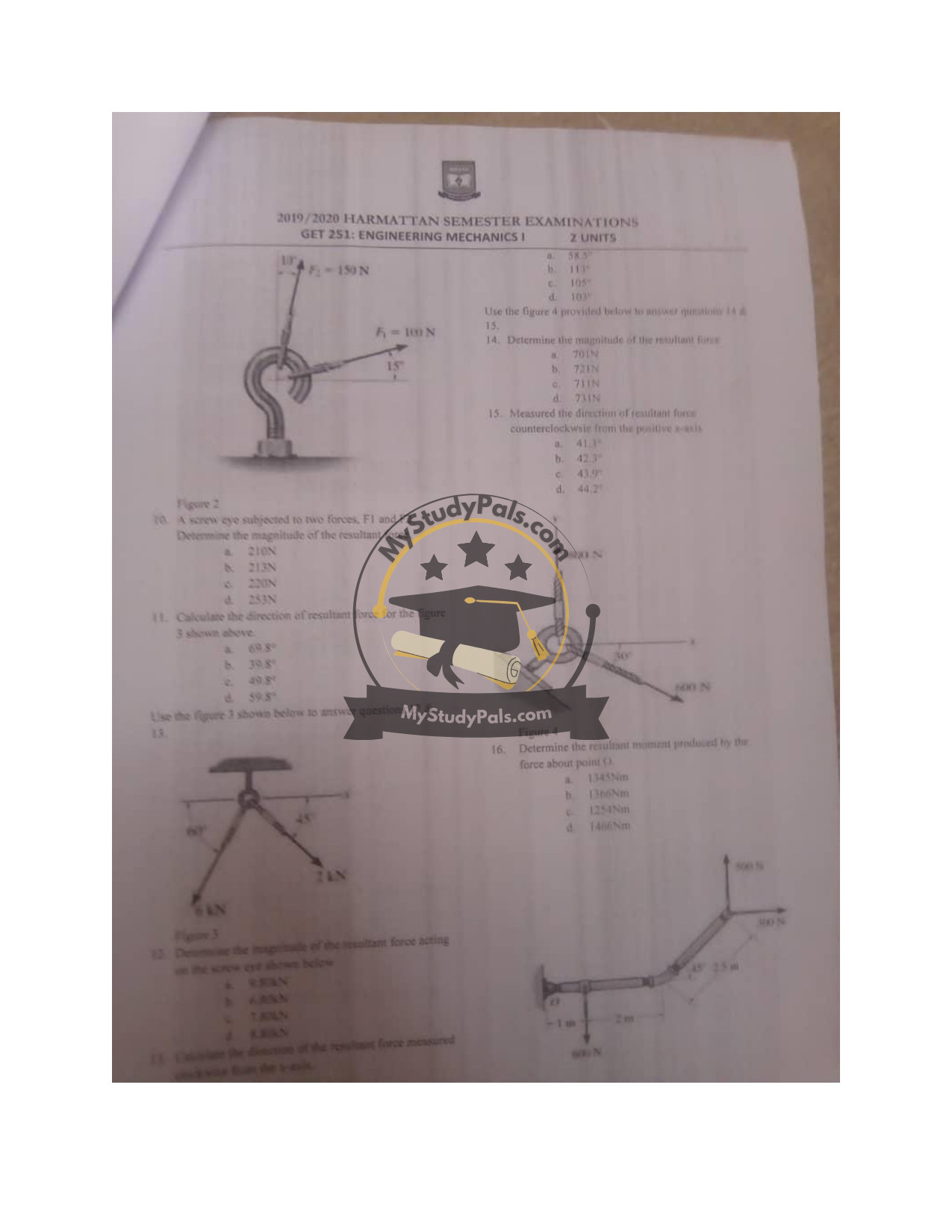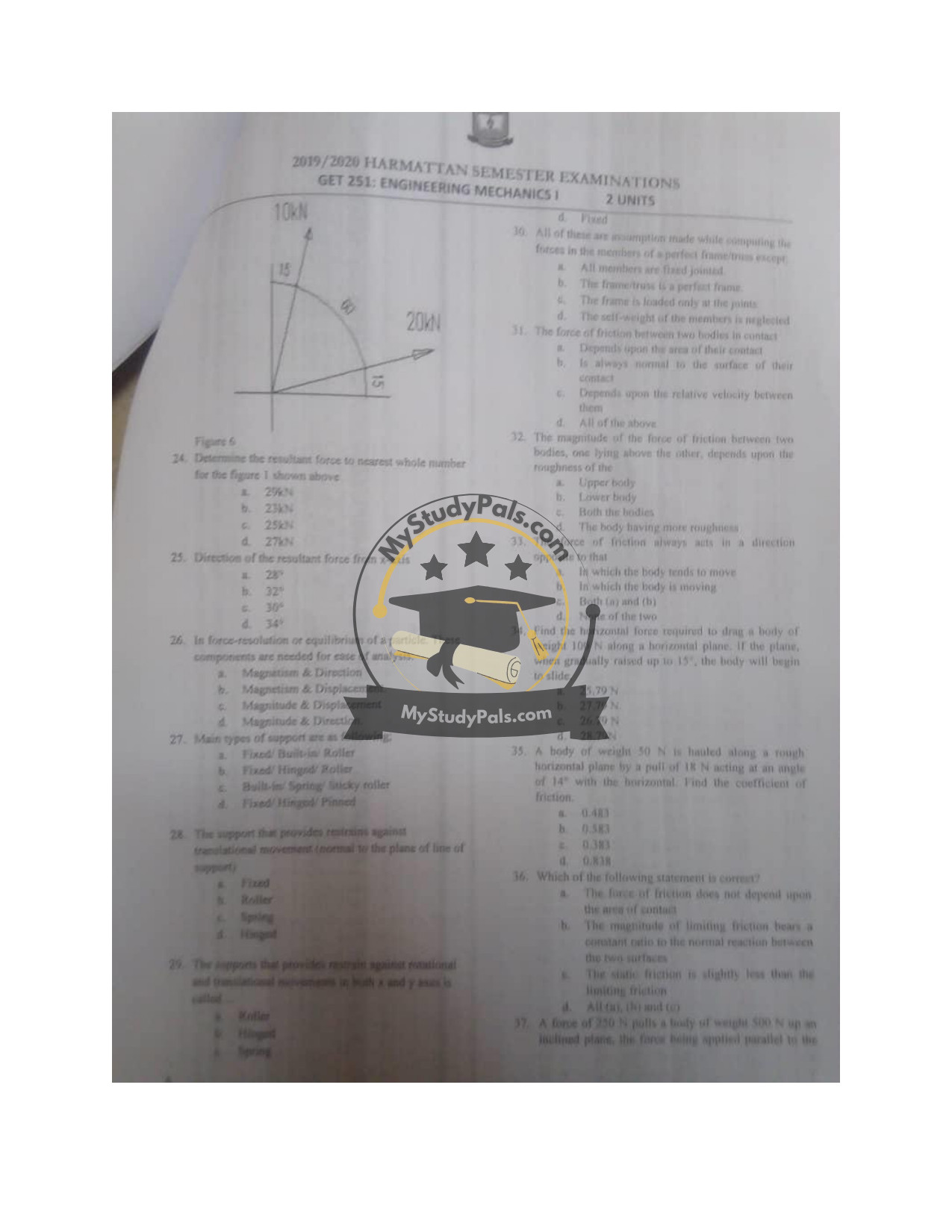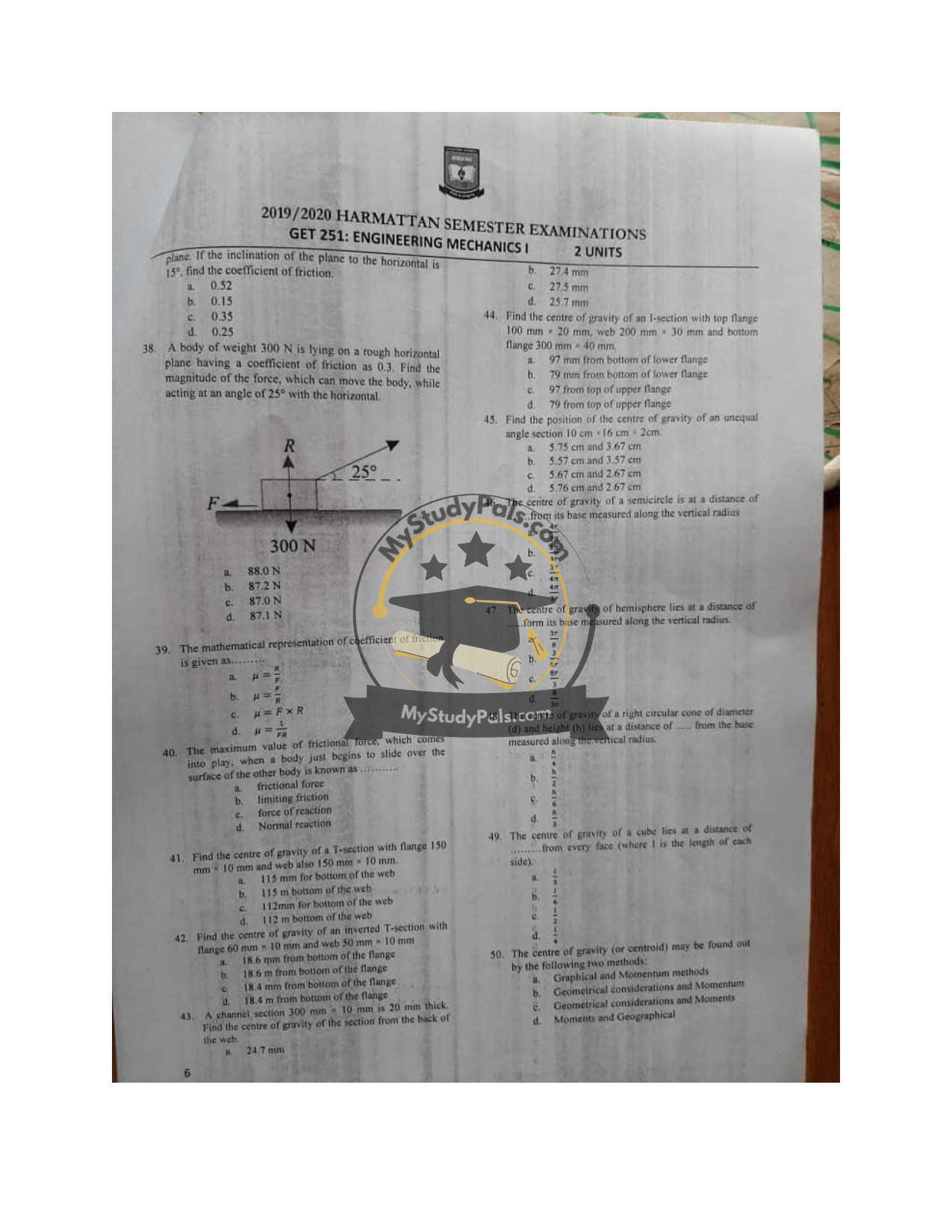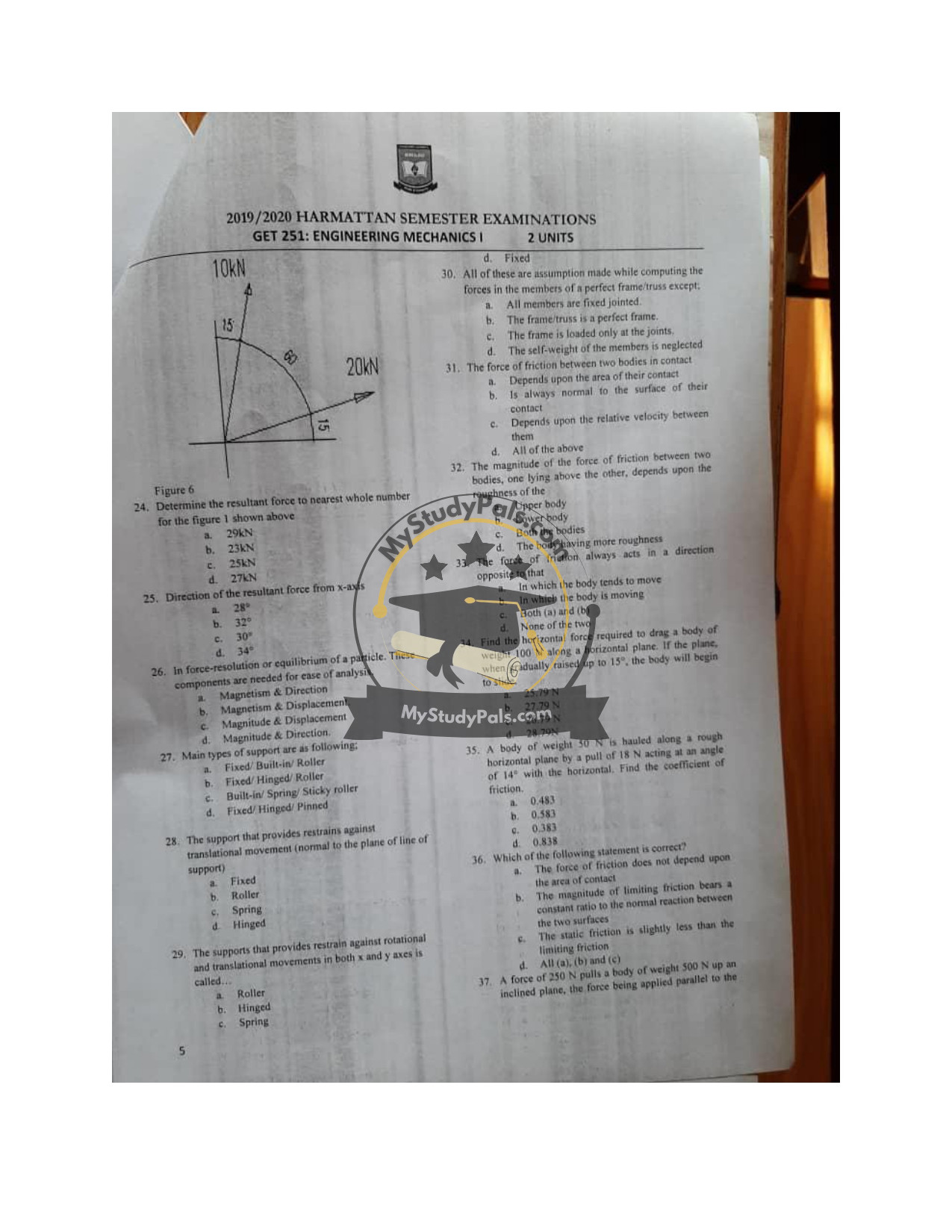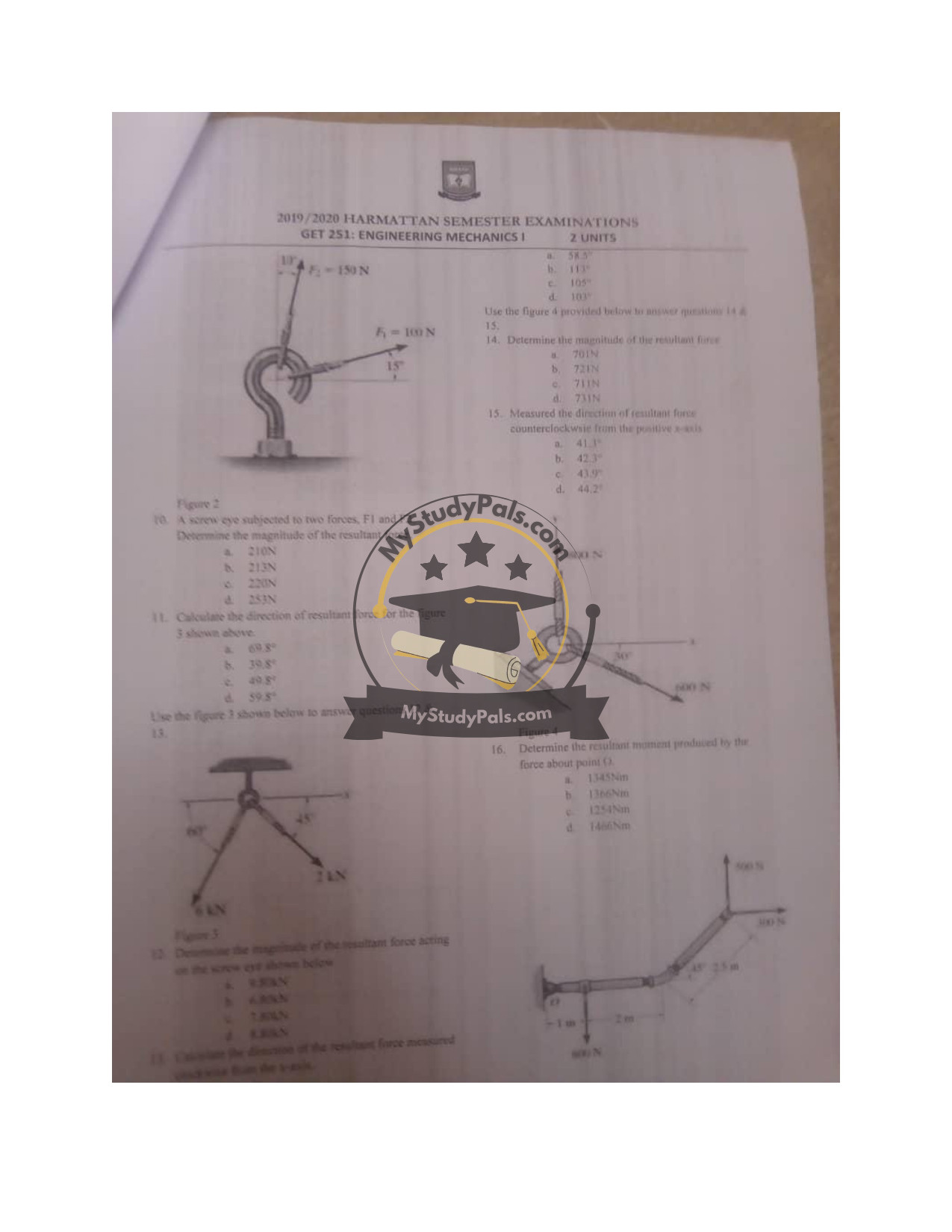ANWSER
Question 1:
The fundamental of Engineering mechanics is based on…
Answer: a. Isaac Newton’s laws of Motion
Question 2:
When two or more forces have their lines of action on the same line (or axis), The force system is called…
Answer: d. Collinear
Question 3:
… is a drawing that shows the particle with all the forces that act on it and make it look like “free from its surrounding”
Answer: d. Free-Body Diagram (FBD)
Question 4:
All of these are assumption made while computing the forces in the members of a perfect frame/fruss except:
Answer: b. All members are fixed jointed
Question 5:
Engineering mechanics is known as applied mechanics because it involved the applications of
Answer: b. Physics & Mathematics
Question 6:
Resolution of forces along x-axis, \(\sum F_x =\)
Answer: a. 2.5 kN
Question 7:
Resolution of forces along y-axis, \(\sum F_y =\)
Answer: b. 6.5 kN
Question 8:
Resultant forces, R =
Answer: d. 6.7 kN
Question 9:
The direction of resultant forces along x-axis,
Answer: a. 72.00°
Question 10:
A screen eye subjected to two forces, F1 and F2. Determine the magnitude of the resultant force.
Answer: b. 213N
Question 11:
Calculate the direction of resultant force for the figure 3 shown above.
Answer: d. 59.8°
Question 12:
Determine the magnitude of the resultant force acting on the screen eye shown below.
Answer: c. 7.5%
Question 14:
Determine the magnitude of the resultant force.
Answer: c. 711N
Question 15:
Measured the direction of resultant force counterclockwise from the positive x-axis.
Answer: a. 41.3°
Question 16:
Determine the resultant moment produced by the force about point ().
Answer: b. 1366Nm
Question 17:
Determine the resultant couple moment acting clockwise on the beam.
Answer: b. 720Nm
Question 18:
Determine the magnitude of F so that the resultant couple moment acting on the beam \(1.5\)kNm clockwise.
Answer: d. 2.33kN
Question 19:
Determine the force in member A\(_1\)
Answer: b. 750N (T)
Question 20:
Determine the force in member AD
Answer: a. 750N (C)
Question 21:
Determine the force in member DC
Answer: b. 600N (T)
Question 22:
Determine the force in member CB
Answer: c. 600N (C)
Question 23:
STATICS:
Answer: c. Study of the effect of force(s) on the equilibrium of body at rest or at a constant velocity.
Question 24:
Determine the resultant force to nearest whole number for the figure 1 shown above.
Answer: d. 27kN
Question 25:
Direction of the resultant force from x-axis
Answer: c. 30°
Question 26:
In force-resolution or equilibrium of a particle. These components are needed for ease of analysis.
Answer: d. Magnitude & Direction
Question 27:
Main types of support are as following.
Answer: b. Fixed/Hinged/Roller
Question 28:
The support that provides restrains against translational movement (normal to the plane of line of support).
Answer: b. Roller
Question 29:
The supports that provides restrain against rotational and translational movements in both x and y axes is called…
Answer: d. Fixed
Question 30:
All of these are assumptions made while computing the forces in the members of a perfect frame/trans except.
Answer: a. All members are fixed jointed
Question 31:
The force of friction between two bodies in contact.
Answer: d. All of the above
Question 32:
The magnitude of the force of friction between two bodies, one lying above the other, depends upon the roughness of the
Answer: c. Both the bodies
Question 33:
The force of friction always acts in a direction opposite to that.
Answer: c. Both (a) and (b)
Question 34:
Find the horizontal force required to drag a body of weight 100 N along a horizontal plane. If the plane, when gradually raised up to 15°, the body will begin to slide.
Answer: c. 26,79 N
Question 35:
A body of weight 50 N is hauled along a rough horizontal plane by a pull of 18 N acting at an angle of 14° with the horizontal. Find the coefficient of friction.
Answer: a. 0.483
Question 36:
Which of the following statement is correct?
Answer: d. All (a), (b) and (c)
Question 37:
A force of 250 N pulls a body of weight 500 N up an inclined plane, the force being applied parallel to the…
Answer: [Incomplete question, answer cannot be determined]
Question 38:
A body of weight 300 N is lying on a rough horizontal plane having a coefficient of friction as 0.3. Find the magnitude of the force, which can move the body, while acting at an angle of 25° with the horizontal.
Answer: b. 87.2 N
Question 39:
The mathematical representation of coefficient of friction is given as…
Answer: [No correct option provided; typically, \(\mu = \frac{F}{N}\)]
Question 40:
The maximum value of frictional force, which comes into play, when a body just begins to slide over the surface of the other body is known as…
Answer: b. limiting friction
Question 41:
Find the centre of gravity of a T-section with flange 150 mm ÷ 10 mm and web also 150 mm ÷ 10 mm.
Answer: c. 112 mm for bottom of the web
Question 42:
Find the centre of gravity of an inverted T-section with flange 60 mm ÷ 10 mm and web 50 mm ÷ 10 mm.
Answer: c. 18.4 mm from bottom of the flange
Question 43:
A channel section 300 mm ÷ 10 mm is 20 mm thick. Find the centre of gravity of the section from the back of the web.
Answer: b. 27.5 mm
Question 44:
Find the centre of gravity of an i-section with top flange 100 mm × 20 mm, web 200 mm × 30 mm and bottom flange 300 mm × 40 mm.
Answer: a. 97 mm from bottom of lower flange
Question 45:
Find the position of the centre of gravity of an unequal angle section 10 cm ÷ 16 cm ÷ 2cm.
Answer: c. 5.67 cm and 2.67 cm
Question 46:
The centre of gravity of a semicircle is at a distance of ……from its base measured along the vertical radius.
Answer: [No correct option provided; typically, \(\frac{4r}{3\pi}\)]
Question 47:
The centre of gravity of hemisphere lies at a distance of ……from its base measured along the vertical radius.
Answer: b. \(\frac{3r}{8}\)
Question 48:
The centre of gravity of a right circular cone of diameter (d) and height (h) lies at a distance of ……from the base measured along the vertical radius.
Answer: a. \(\frac{h}{4}\)
Question 49:
The centre of gravity of a cube lies at a distance of ……from every face (where l is the length of each side).
Answer: a. \(\frac{l}{2}\)
Question 50:
The centre of gravity (or centroid) may be found out by the following two methods:
Answer: c. Geometrical considerations and Moments
Question 1:
Answer: b. 5.8°
Question 2:
Answer: c. 165°
Question 3:
Answer: b. 213N
Question 4:
Answer: a. 68.9°
Question 5:
Answer: c. 4.85N
Question 6:
Answer: d. 63.43°
Question 7:
Answer: a. 721N
Question 8:
Answer: b. 41.1°
Question 9:
Answer: b. 1364Nm
Question 10:
Answer: a. 29kN
Question 11:
Answer: a. 28°
Question 12:
Answer: e. Magnitude & Direction
Question 13:
Answer: a. Fixed / Built-in / Roller
Question 14:
Answer: a. Fixed
Question 15:
Answer: d. All of the above
Question 16:
Answer: d. Both the bodies
Question 17:
Answer: c. Opposite to that in which the body is moving
Question 18:
Answer: b. 26.79N
Question 19:
Answer: a. 0.481
Question 20:
Answer: d. All (a), (b), and (c)


